
Introduction
Congratulations on your purchase and welcome to
Philips! To fully benet from the support that Philips offers,
register your product at www.philips.com/welcome.
General description (Fig. 1)
A Handle
B Setting indicator
C On/off switch
D Socket for appliance plug
E Micro shaver
F Hair clipping comb
G Setting selector
H Nose/ear hair trimmer
I Precision timmer
J Precision comb
K Micro trimmer
L Cutting element
M Beard trimming comb
N Cleaning brush
O Adapter
P Appliance plug
Q Charging light
R Stand
Important
Read this user manual carefully before you use the
appliance and save it for future reference.
Danger
- Make sure the adapter does not get wet.
Warning
- Check if the voltage indicated on the adapter and on
the appliance corresponds to the local mains voltage
before you connect the appliance.
- The adapter contains a transformer. Do not cut
off the adapter to replace it with another plug, as
this causes a hazardous situation.
- This appliance is not intended for use by persons
(including children) with reduced physical, sensory
or mental capabilities, or lack of experience and
knowledge, unless they have been given supervision
or instruction concerning use of the appliance by a
person responsible for their safety.
- Children should be supervised to ensure that they
do not play with the appliance.
Caution
- Use, charge and store the appliance at a temperature
between 15°C and 35°C.
- Only use the adapter supplied to charge the
appliance.
- If the adapter is damaged, always have it replaced
with one of the original type in order to avoid a
hazard.
- Do not use the appliance when one of the
attachments or combs is damaged or broken as this
may cause injury.
- Be careful with hot water. Always check if the water
is not too hot, to prevent your hands from getting
burnt.
- This appliance is only intended for clipping human
scalp hair and for trimming and grooming the human
beard, moustache, sideburns, nose hair, ear hair and
eyebrows. Do not use it for another purpose.
- Never try to trim your eyelashes.
- If the appliance is subjected to a major change in
temperature, pressure or humidity, let the appliance
acclimatise for 30 minutes before you use it.
Compliance with standards
- The appliance complies with the internationally
approved IEC safety regulations and can be safely
used in the bath or shower and cleaned under the
tap (Fig. 2).
- This Philips appliance complies with all standards
regarding electromagnetic elds (EMF). If handled
properly and according to the instructions in this
user manual, the appliance is safe to use based on
scientic evidence available today.
Preparing for use
Charging
Charge the appliance for at least 10 hours before you use
it for the rst time and after a long period of disuse.
When the appliance is fully charged, it has a cordless
operating time of up to 35 minutes. Do not charge the
appliance for more than 24 hours.
The appliance does not run from the mains.
You cannot charge the appliance in the stand.
1 Insert the appliance plug into the socket of
the appliance and put the adapter in the wall
socket (Fig. 3).
, The charging light on the adapter goes on to
indicate that the appliance is charging (Fig. 4).
Note: The charging light does not change colour and does
not go out when the appliance is fully charged.
Optimising the lifetime of the rechargeable
battery
- Remove the adapter from the wall socket when the
battery is fully charged (which takes 10 hours).
- Do not leave the appliance plugged into the wall
socket for more than 24 hours.
- Discharge the battery completely twice a year
by letting the motor run until it stops. Then fully
recharge the battery.
Attaching/detaching attachments
All attachments (cutting element, precision trimmer, micro
trimmer, micro shaver and nose/ear hair trimmer) can be
attached and detached in the same way.
1 To attach the attachment, push it onto the
handle (Fig. 5).
2 To detach the attachment, pull it off the
handle. (Fig. 6)
Hair clipping
Preparing for hair clipping
Make sure that the appliance is fully charged when you
start clipping.
It is not possible to run the appliance from the mains.
Only use the appliance on clean, dry hair. Do not use it
on freshly washed hair.
1 Make sure that the head of the person whose hair
you intend to cut is at the same level as your chest.
This ensures that all parts of the head are clearly
visible and within easy reach.
2 Comb the hair in the direction of growth (Fig. 7).
3 Put the cutting element on the handle (see
section ‘Attaching/detaching attachments’ in chapter
‘Preparing for use’).
Clipping with hair clipping comb
1 Slide the hair clipping comb into the guiding
grooves on both sides of the handle (‘click’) (Fig. 8).
2 Press the setting selector upwards or downwards
to set the desired setting (Fig. 9).
, The setting indicator on the back of the appliance
shows the selected setting. (Fig. 10)
The table shows how long the hair will be after clipping at
the different settings.
When you clip for the rst time, start at the highest
setting (9) to familiarise yourself with the appliance.
Settings of hair clipping comb
Setting 1 2 3 4 5 6 7 8 9
Hair length after
clipping(mm)
4 6 8 10 12 14 16 18 20
Tip: Write down the hair length settings you have used to
create a certain hairstyle as a reminder for future clipping
sessions.
3 Switch on the appliance.
4 Move the appliance through the hair slowly.
- To clip in the most effective way, move the appliance
against the direction of hair growth.
- Since all hair does not grow in the same direction,
you need to move the appliance in different
directions (upward, downward or across) (Fig. 11).
- Make sure that the at part of the comb is always
fully in contact with the scalp to obtain an even
result.
- Make overlapping passes over the head to ensure
that you cut all the hair that needs to be cut.
- To achieve a good result with curly, sparse or long
hair, use a comb to guide the hair towards the
appliance.
5 Regularly remove cut hair from the comb.
If a lot of hair has accumulated in the comb, remove the
comb from the appliance and blow and/or shake the hair
out of it.
Contouring without hair clipping comb
You can use the appliance without hair clipping comb to
clip hair very close to the skin (0.6mm) or to contour the
neckline and the area round the ears.
Be careful when you clip without comb because the
cutting element removes every hair it touches.
1 Press the setting selector upwards and pull the
comb off the handle. (Fig. 12)
2 Before you start to contour the hairline round the
ears, comb the hair ends over the ears.
3 Tilt the appliance in such a way that only one edge
of the cutting element touches the hair ends when
you shape the contours round the ears (Fig. 13).
Only cut the hair ends. The hairline should be close to
the ear.
4 To contour the neckline and sideburns, turn the
appliance and make downward strokes (Fig. 14).
Move the appliance slowly and smoothly. Follow the
natural hairline.
Cutting shapes with micro trimmer
You can use the micro trimmer to cut shapes in scalp hair.
It cuts hair very close to the skin (0.6mm).
Be careful when you use the micro timmer because it
removes every hair it touches.
1 Put the micro trimmer on the handle (see section
‘Attaching/detaching attachments’ in chapter
‘Preparing for use’).
2 Make careful and controlled movements with the
micro trimmer.
- To achieve a good cutting result, move the trimmer
against the direction of hair growth.
- Always make sure the micro trimmer is fully in
contact with the skin.
Trimming
Preparing for trimming
Make sure that the appliance is fully charged before you
start trimming.
It is not possible to run the appliance from the mains.
1 Comb the hair to be trimmed (beard, moustache,
sideburns, eyebrows) with a ne comb.
2 Put the cutting element on the handle (see section
‘Attaching/detaching attachments’ in chapter
‘Preparing for use’).
Beard trimming with beard trimming comb
1 Slide the beard trimming comb into the
guiding grooves on both sides of the handle
(‘click’) (Fig. 15).
2 Press the setting selector upwards or downwards
to set the desired setting (Fig. 16).
, The setting indicator on the back of the appliance
shows the selected setting.
The table shows how long the hair will be after trimming
at the different settings.
When you trim for the rst time, start at the highest
setting (9) to familiarise yourself with the appliance.
Settings of beard trimming comb
Settings 1 2 3 4 5 6 7 8 9
Hair length after
trimming(mm)
2 4 6 8 10 12 14 16 18
3 Switch on the appliance.
4 Move the appliance through the hair slowly (Fig. 17).
- To trim in the most effective way, move the appliance
against the direction of hair growth.
- Since all hair does not grow in the same direction,
you need to move the appliance in different
directions (upward or across).
- Make sure that the at part of the comb is always
fully in contact with the skin to obtain an even result.
5 Regularly remove cut hair from the comb.
If a lot of hair has accumulated in the comb, remove the
comb from the appliance and blow and/or shake the hair
out of it.
Trimming at the ‘stubble look’ setting
1 To create a ‘stubble look’, trim with the beard
trimming comb set to hair length setting 1. (Fig. 18)
Beard trimming without beard trimming
comb
Use the beard trimmer without the beard trimming comb
to contour your beard and to remove single hairs.
Cutting without comb results in a very short stubble
beard (0.6mm).
1 Press the setting selector upwards and pull the
beard trimming comb off the handle (Fig. 19).
2 Make careful and controlled movements with
the beard trimmer. Touch the hair lightly with the
cutting element.
Beard trimming with precision trimmer
and precision comb
Use the precision trimmer with the precision comb to
trim smaller areas and to create designer beards.
1 Put the precision trimmer on the handle (see
section ‘Attaching/detaching attachments’ in chapter
‘Preparing for use’).
2 Slide the precision comb into the guiding grooves
on both sides of the handle (‘click’) (Fig. 20).
3 Press the setting selector upwards or downwards
to set the desired setting. (Fig. 21)
, The setting indicator on the back of the appliance
shows the selected setting.
The table shows how long the hair will be after trimming
at the different settings.
When you trim for the rst time, start at the highest
setting (4) to familiarise yourself with the appliance.
Settings of precision comb
Setting 1 2 3 4
Hair length after trimming (mm) 2 4 6 8
Beard trimming with precision trimmer but
without precision comb
Use the precision trimmer without the precision comb to
shape your moustache and sideburns, to dene contours
and to remove single hairs.
1 Press the setting selector upwards and pull the
precision comb off the handle (Fig. 22).
2 Hold the appliance upright and trim the desired
areas (Fig. 23).
Grooming facial hair (nose hair, ear hair and
eyebrows)
Trimming nose hair
1 Put the nose/ear hair trimmer on the handle (see
section ‘Attaching/detaching attachments’ in chapter
‘Preparing for use’).
2 Make sure your nostrils are clean.
3 Switch on the appliance and insert the tip of the
trimmer into one of your nostrils. (Fig. 24)
Do not insert the tip more than 0.5cm into your nostril.
4 Slowly move the tip in and out while turning it
round at the same time to remove unwanted hair.
To reduce the tickling effect, make sure that you press the
side of the tip rmly pressed against the skin.
Trimming ear hair
1 Put the nose/ear hair trimmer on the handle (see
section ‘Attaching/detaching attachments’ in chapter
‘Preparing for use’).
2 Clean the outer ear channel. Make sure it is free
from wax.
3 Switch on the appliance and move the tip softly
round the ear to remove hairs that stick out
beyond the rim of the ear. (Fig. 25)
4 Carefully insert the tip into the outer ear
channel. (Fig. 26)
Do not insert the tip more than 0.5cm into the ear
channel as this could damage the eardrum.
Trimming eyebrows with precision trimmer
and precision comb
Use the precision trimmer with the precision comb to
trim entire eyebrows to a uniform length.
Never trim your eyelashes. Never come too close to
your eyes.
1 Comb the eyebrows in the direction of hair
growth (Fig. 27).
2 Put the precision trimmer on the handle (see
section ‘Attaching/detaching attachments’ in chapter
‘Preparing for use’).
3 Slide the precision comb into the guiding grooves
on both sides of the handle (‘click’) (Fig. 20).
4 Press the setting selector upwards or downwards
to set the desired setting. (Fig. 21)
, The setting indicator on the back of the appliance
shows the selected setting.
The table shows how long the hair will be after trimming
at the different settings.
When you trim for the rst time, start at the highest
setting (4) to familiarise yourself with the appliance.
Settings of precision comb
Setting 1 2 3 4
Hair length after trimming (mm) 2 4 6 8
5 Move precision trimmer over the eyebrow from
the outer tip of the eyebrow towards the base of
the nose. (Fig. 28)
Contouring eyebrows/removing single facial
hairs with micro trimmer
Use the micro trimmer to shape and dene eyebrows
and to remove single facial hairs
Never trim your eyelashes. Never come too close to
your eyes.
Do not use micro trimmer too close to a mirror.
1 Put the micro trimmer on the handle (see section
‘Attaching/detaching attachments’ in chapter
‘Preparing for use’).
2 When you contour eyebrows, stretch the skin of
the eyelid (Fig. 29).
3 Make careful and controlled movements with the
micro trimmer.
- Always move the micro trimmer against the direction
of hair growth.
- Always make sure the micro trimmer is fully in
contact with the skin.
Shaving
Shaving with the micro shaver
Use the micro shaver to create smooth, well-dened
contours.
Before you use the micro shaver, always check it for
damage or wear. If the foil or cutter is damaged or
worn, do not use the micro shaver, as injury may occur.
If the foil is damaged, replace the top part of the micro
shaver and if the cutter is damaged, replace the whole
attachment before you use the micro shaver again.
1 Pre-trim the contours you want to shave with the
cutting element without comb or the precision
trimmer without comb.
2 Put the micro shaver on the handle (see
section ‘Attaching/detaching attachments’ in chapter
‘Preparing for use’).
3 Gently press the micro shaver onto the skin
and shave along contoured edges to remove any
stubble.
Do not press too hard.
Cleaning
Never use compressed air, scouring pads, abrasive
cleaning agents or aggressive liquids such as petrol or
acetone to clean the appliance.
Note: The appliance does not need any lubrication.
Clean the appliance every time you have used it.
1 Make sure the appliance is switched off and
disconnected from the socket.
2 Remove any comb and/or attachment from the
appliance.
3 If you have used the micro shaver, separate its top
part from its body (Fig. 30).
The shaving foil is very delicate. Handle it carefully.
Replace the top part of the micro shaver if the shaving
foil is damaged.
Do not clean the shaving foil with the brush, as this may
cause damage.
4 Blow and/or shake out any hair that has
accumulated in the attachments and/or combs.
5 Clean the attachments, the combs and the
appliance with lukewarm water or with the cleaning
brush.
6 Clean the adapter with the cleaning brush or a dry
cloth.
Keep the adapter dry.
Storage
Store the appliance and attachments in the charging stand
to prevent damage.
Replacement
If the adapter is damaged, always have it replaced with
one of the original type in order to avoid a hazard.
Only replace damaged or worn attachments or combs
with original Philips replacement attachments or combs
Philips replacement attachments, combs and adapters are
available from your Philips dealer and authorised Philips
service centres.
If you have any difculties obtaining an adapter or
replacement attachments and combs for the appliance,
contact the Philips Customer Care Centre in your
country (you nd its phone number in the worldwide
guarantee leaet).
Environment
- Do not throw away the appliance with the normal
household waste at the end of its life, but hand it in
at an ofcial collection point for recycling. By doing
this, you help to preserve the environment (Fig. 31).
- The built-in rechargeable battery contains substances
that may pollute the environment. Always remove
the battery before you discard and hand in the
appliance at an ofcial collection point. Dispose of
the battery at an ofcial collection point for batteries.
If you have trouble removing the battery, you can
also take the appliance to a Philips service centre.
The staff of this centre will remove the battery for
you and will dispose of it in an environmentally safe
way. (Fig. 32)
Disposal of the battery
Only remove the battery when it is completely empty.
1 Disconnect the appliance from the mains and let
the appliance run until the motor stops.
2 Remove any comb and/or attachment from the
appliance.
3 Remove the top part of the appliance with a
screwdriver (Fig. 33).
4 Pull the inner part out of the appliance (Fig. 34).
5 Pry open the inner part and pull out the
battery (Fig. 35).
6 Cut the wires close to the battery with a pair of
household scissors.
Do not connect the appliance to the mains again after
you have removed the battery.
Guarantee & service
If you need service or information or if you
have a problem, please visit the Philips website at
www.philips.com or contact the Philips Consumer Care
Centre in your country (you nd its phone number in
the worldwide guarantee leaet). If there is no Consumer
Care Centre in your country, go to your local Philips
dealer.
ENGLISH
QG3193, QG3190
POLSKI
Wprowadzenie
Gratulujemy zakupu i witamy wśród użytkowników
produktów Philips! Aby w pełni skorzystać z oferowanej
przez rmę Philips pomocy, zarejestruj swój produkt na
stronie www.philips.com/welcome.
Opis ogólny (rys. 1)
A Uchwyt
B Wskaźnik ustawienia
C Wyłącznik
D Gniazdo do podłączenia zasilacza
E Minigolarka
F Nasadka grzebieniowa do strzyżenia włosów
G Przełącznik ustawień
H Trymer do przycinania włosów w nosie i uszach
I Precyzyjny trymer
J Precyzyjny grzebień
K Minitrymer
L Element tnący
M Nasadka grzebieniowa do przycinania brody
N Szczoteczka do czyszczenia
O Zasilacz
P Wtyczka zasilacza
Q Wskaźnik ładowania
R Stojak
Przed pierwszym użyciem urządzenia zapoznaj się
dokładnie z jego instrukcją obsługi i zachowaj ją na
wypadek konieczności użycia w przyszłości.
- Zabezpiecz zasilacz przed możliwością zamoknięcia.
- Przed podłączeniem urządzenia upewnij się, czy
napięcie podane na zasilaczu i urządzeniu jest zgodne
z napięciem w sieci elektrycznej.
- Zasilacz sieciowy zawiera transformator. Ze
względów bezpieczeństwa nie wymieniaj wtyczki
zasilacza na inną.
- Urządzenie nie jest przeznaczone do użytku przez
osoby (w tym dzieci) z ograniczonymi zdolnościami
zycznymi, sensorycznymi lub umysłowymi, a
także nieposiadające wiedzy lub doświadczenia w
użytkowaniu tego typu urządzeń, chyba że będą one
nadzorowane lub zostaną poinstruowane na temat
korzystania z tego urządzenia przez opiekuna.
- Nie pozwalaj dzieciom bawić się urządzeniem.
Uwaga
- Używaj, ładuj i przechowuj urządzenie w
temperaturze od 15°C do 35°C.
- Do ładowania urządzenia używaj wyłącznie
dołączonego zasilacza.
- W przypadku uszkodzenia zasilacza wymień go
na nowy tego samego typu w sieci punktów
serwisowych współpracujących z Philips Polska Sp z
o.o.
- Nie korzystaj z urządzenia w przypadku uszkodzenia
nasadki lub grzebienia, ponieważ może to
spowodować skaleczenia.
- Uważaj na gorącą wodę. Zawsze należy sprawdzić jej
temperaturę, aby nie poparzyć rąk.
- Niniejsze urządzenie przeznaczone jest wyłącznie
do strzyżenia włosów na głowie, a także przycinania
brody, wąsów, bokobrodów, włosów w nosie, uszach
oraz brwi.
- Nigdy nie próbuj przycinać rzęs.
- Jeśli urządzenie było narażone na duże zmiany
temperatury, ciśnienia lub wilgotności, przed użyciem
należy je aklimatyzować przez 30 minut.
- Urządzenie spełnia międzynarodowe normy
bezpieczeństwa IEC i może być używane w
kąpieli i pod prysznicem oraz może być myte pod
wodą (rys. 2).
- Niniejsze urządzenie rmy Philips spełnia wszystkie
normy dotyczące pól elektromagnetycznych. W
przypadku prawidłowej obsługi zgodnie z zaleceniami
zawartymi w instrukcji urządzenie jest bezpieczne
w użytkowaniu, co potwierdzają badania naukowe
dostępne na dzień dzisiejszy.
- Poziom hałasu: Lc = 64 dB [A]
Przed pierwszym użyciem lub po długim okresie
nieużywania urządzenie należy ładować co najmniej przez
10 godzin.
W pełni naładowane urządzenie może działać
bezprzewodowo do 35 minut. Nie ładuj akumulatora
dłużej niż 24 godziny.
Urządzenie to nie ma możliwości podłączenia do sieci
elektrycznej.
Urządzenia nie można ładować na podstawce.
1 Włóż wtyczkę zasilacza do gniazda w urządzeniu, a
zasilacz do gniazdka elektrycznego (rys. 3).
, Na zasilaczu zapali się wskaźnik ładowania
informujący o ładowaniu urządzenia (rys. 4).
Uwaga: Po całkowitym naładowaniu urządzenia wskaźnik
ładowania nie zmienia koloru ani nie gaśnie.
Optymalizacja okresu eksploatacji
akumulatora
- Po całkowitym naładowaniu akumulatora, które trwa
10 godzin, wyjmij zasilacz z gniazdka elektrycznego.
- Nie pozostawiaj urządzenia podłączonego do
gniazdka elektrycznego na dłużej niż 24 godziny.
- Dwa razy w roku całkowicie rozładuj akumulator,
pozwalając, by urządzenie działało, aż do
samoczynnego zakończenia pracy. Następnie naładuj
go.
Wszystkie nasadki (element tnący, precyzyjny trymer,
minitrymer, minigolarka i trymer do przycinania włosów w
nosie i uszach) zakłada się i zdejmuje w ten sam sposób.
1 Aby założyć nasadkę, dociśnij ją do uchwytu (rys. 5).
2 Aby zdjąć nasadkę, ściągnij ją z uchwytu. (rys. 6)
Przed rozpoczęciem strzyżenia sprawdź, czy urządzenie
jest w pełni naładowane.
Nie ma możliwości zasilania urządzenia z sieci
elektrycznej.
Używaj urządzenia wyłącznie na czystych i suchych
włosach. Nie używaj go na świeżo umytych włosach.
1 Przed rozpoczęciem strzyżenia zwróć uwagę,
aby głowa osoby strzyżonej znajdowała się na
wysokości torsu strzygącego. Zapewnia to dobrą
widoczność i łatwą dostępność wszystkich stron
głowy.
2 Rozczesz włosy zgodnie z kierunkiem ich
wzrostu (rys. 7).
3 Załóż element tnący na uchwyt (patrz część
„Zakładanie i zdejmowanie nasadek” w rozdziale
„Przygotowanie do użycia”).
1 Wsuń nasadkę grzebieniową do strzyżenia
włosów w rowki po bokach urządzenia (usłyszysz
„kliknięcie”) (rys. 8).
2 Wybierz żądane ustawienie, przesuwając w górę lub
w dół przełącznik ustawień (rys. 9).
, Wybrane ustawienie jest pokazywane przez
wskaźnik z tyłu urządzenia. (rys. 10)
Tabela przedstawia długość włosów po strzyżeniu z
różnymi ustawieniami.
W przypadku strzyżenia po raz pierwszy ustaw na
początek maksymalne ustawienie (9), aby zapoznać się z
urządzeniem.
Ustawienia nasadki grzebieniowej do
Ustawienie 1 2 3 4 5 6 7 8 9
Długość włosów po
strzyżeniu(mm)
4 6 8 10 12 14 16 18 20
Wskazówka: Zanotuj ustawienia długości włosów dla danej
fryzury, tak aby można ich było użyć w przyszłości.
3 Włącz urządzenie.
4 Powoli przesuwaj urządzenie po włosach.
- Przesuwaj urządzenie w kierunku przeciwnym do
wzrostu włosów, aby uzyskać najlepsze efekty.
- W związku z tym, że nie wszystkie włosy rosną
w tym samym kierunku, zmieniaj kierunek
przesuwania urządzenia (pod włos, z włosem lub pod
kątem) (rys. 11).
- Zwróć uwagę na to, aby płaska część nasadki
grzebieniowej zawsze dotykała głowy. Pozwoli to na
równe strzyżenie włosów.
- Strzyż włosy pasmami, aby objąć wszystkie partie
wymagające przycięcia.
- W przypadku włosów kręconych, rzadkich lub długich
do skierowania włosów w stronę urządzenia użyj
nasadki grzebieniowej.
5 Regularnie usuwaj ścięte włosy z nasadki
grzebieniowej.
Jeśli w nasadce zgromadzi się dużo włosów, zdejmij ją z
urządzenia i wydmuchaj lub wytrząśnij włosy.
Aby obciąć włosy na bardzo krótkie (0,6 mm) lub
przystrzyc włosy na karku i wokół uszu, z urządzenia
należy zdjąć nasadkę grzebieniową.
Podczas strzyżenia bez nasadki grzebieniowej należy
zachować szczególną ostrożność, gdyż w takim
przypadku przycinany jest każdy włos.
1 Przesuń przełącznik ustawień w górę i zdejmij
grzebień z uchwytu. (rys. 12)
2 Przed przycięciem włosów wokół uszu uczesz
końce włosów nad uszami.
3 Nachyl urządzenie w taki sposób, aby tylko jedna
krawędź elementu tnącego dotykała końców
włosów podczas strzyżenia włosów wokół
uszu (rys. 13).
Przycinaj tylko same końce włosów. Linia włosów powinna
znajdować się blisko uszu.
4 W celu przycięcia włosów na karku i baków
odwróć urządzenie i wykonuj ruchy w dół (rys. 14).
Ruchy urządzeniem powinny być wolne i płynne.
Wystarczy podążać za naturalną linią włosów.
Minitrymer przycina włosy bardzo blisko skóry (0,6 mm),
co pozwala nadać odpowiedni kształt linii włosów na
głowie.
Podczas korzystania z minitrymera należy zachować
szczególną ostrożność, gdyż w takim przypadku
przycinany jest każdy włos.
1 Załóż minitrymer na uchwyt (patrz część
„Zakładanie i zdejmowanie nasadek” w rozdziale
„Przygotowanie do użycia”).
2 Wykonuj minitrymerem spokojne i kontrolowane
ruchy.
- W celu uzyskania najlepszych rezultatów przesuwaj
trymer w kierunku przeciwnym do kierunku wzrostu
włosów.
- Pamiętaj, aby minitrymer zawsze dotykał skóry całą
powierzchnią.
Przycinanie
Przygotowanie do przycinania
Przed rozpoczęciem przycinania należy sprawdzić, czy
urządzenie jest w pełni naładowane.
Nie ma możliwości zasilania urządzenia z sieci
elektrycznej.
1 Za pomocą gęstego grzebienia rozczesz włosy,
które mają być przycinane (brodę, wąsy, bokobrody,
brwi).
2 Załóż element tnący na uchwyt (patrz część
„Zakładanie i zdejmowanie nasadek” w rozdziale
„Przygotowanie do użycia”).
1 Wsuń nasadkę grzebieniową do przycinania
brody w rowki po bokach urządzenia (usłyszysz
„kliknięcie”) (rys. 15).
2 Wybierz żądane ustawienie, przesuwając w górę lub
w dół przełącznik ustawień (rys. 16).
, Wybrane ustawienie jest pokazywane przez
wskaźnik z tyłu urządzenia.
Tabela przedstawia długość włosów po przycinaniu z
różnymi ustawieniami.
W przypadku przycinania po raz pierwszy ustaw na
początek maksymalne ustawienie (9), aby zapoznać się z
urządzeniem.
Ustawienia nasadki grzebieniowej do
przycinania brody
Ustawienia 1 2 3 4 5 6 7 8 9
Długość włosów po
przycięciu(mm)
2 4 6 8 10 12 14 16 18
3 Włącz urządzenie.
4 Powoli przesuwaj urządzenie po włosach (rys. 17).
- Przesuwaj urządzenie w kierunku przeciwnym do
wzrostu włosów, aby uzyskać najlepsze efekty.
- W związku z tym, że nie wszystkie włosy rosną w
tym samym kierunku, zmieniaj kierunek przesuwania
urządzenia (pod włos lub pod kątem).
- Zwróć uwagę na to, aby płaska część nasadki
grzebieniowej zawsze dotykała głowy. Pozwoli to na
równe strzyżenie włosów.
5 Regularnie usuwaj ścięte włosy z nasadki
grzebieniowej.
Jeśli w nasadce zgromadzi się dużo włosów, zdejmij ją z
urządzenia i wydmuchaj lub wytrząśnij włosy.
„kilkudniowy zarost”
1 Aby uzyskać efekt „kilkudniowego zarostu”,
użyj nasadki grzebieniowej do przycinania brody
ustawionego na długość 1. (rys. 18)
Przycinanie brody bez nasadki grzebieniowej
Użycie trymera do brody bez nasadki grzebieniowej
pozwala przystrzyc krawędź brody i usunąć pojedyncze
włosy.
Przycinanie bez nasadki grzebieniowej pozwala uzyskać
bardzo krótki zarost (0,6 mm).
1 Przesuń przełącznik ustawień w górę i zdejmij
nasadkę grzebieniową do przycinania brody z
uchwytu (rys. 19).
2 Podczas przycinania brody wykonuj spokojne
i kontrolowane ruchy i lekko dotykaj włosy
elementem tnącym.
Przycinanie brody z precyzyjnym trymerem
i precyzyjnym grzebieniem
Precyzyjny trymer wraz z precyzyjnym grzebieniem
pozwala przycinać mniejsze obszary i uzyskać fantazyjne
kształty brody.
1 Załóż precyzyjny trymer na uchwyt (patrz część
„Zakładanie i zdejmowanie nasadek” w rozdziale
„Przygotowanie do użycia”).
2 Wsuń precyzyjny grzebień w rowki po bokach
urządzenia (usłyszysz „kliknięcie”) (rys. 20).
3 Wybierz żądane ustawienie, przesuwając w górę lub
w dół przełącznik ustawień. (rys. 21)
, Wybrane ustawienie jest pokazywane przez
wskaźnik z tyłu urządzenia.
Tabela przedstawia długość włosów po przycinaniu z
różnymi ustawieniami.
W przypadku przycinania po raz pierwszy ustaw na
początek maksymalne ustawienie (4), aby zapoznać się z
urządzeniem.
Ustawienia precyzyjnego grzebienia
Ustawienie 1 2 3 4
Długość włosów po przycięciu (mm) 2 4 6 8
Przycinanie brody z precyzyjnym trymerem
bez precyzyjnego grzebienia
Za pomocą precyzyjnego trymera, bez użycia
precyzyjnego grzebienia, można nadać odpowiedni kształt
i kontury wąsom i bokobrodom oraz usuwać pojedyncze
włosy.
1 Przesuń przełącznik ustawień w górę i zdejmij
precyzyjny grzebień z uchwytu (rys. 22).
13
35
343332
313029
282726
252423
222120
191817
161514
1211
1098
765
432
N
O
P
B
D
C
R
A
H
I
L
E
J
M
F
G
G
G
K
Q
1
4203.000.5883.2

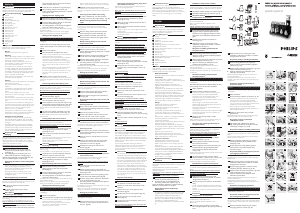



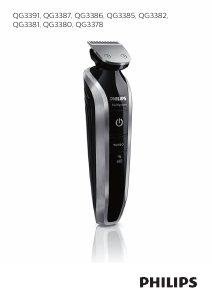
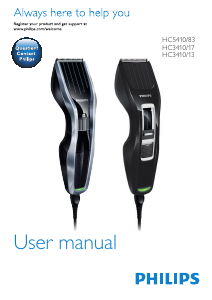
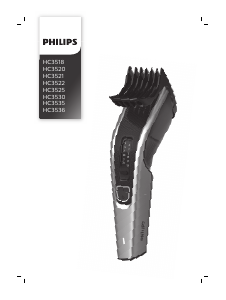

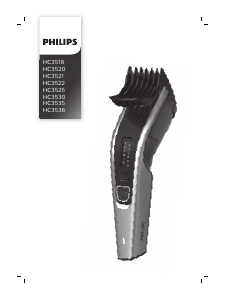
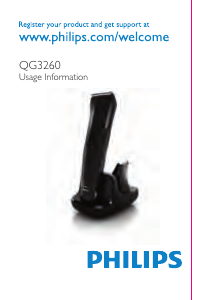
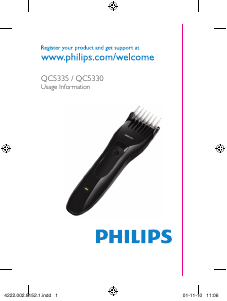
Dołącz do dyskusji na temat tego produktu
Tutaj możesz podzielić się swoją opinią na temat Philips QG3190 Strzyżarka do włosów. Jeśli masz pytanie, najpierw dokładnie przeczytaj instrukcję. Zapytanie o instrukcję można złożyć za pomocą naszego formularza kontaktowego.